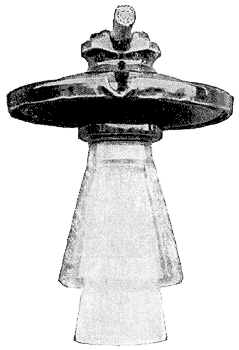[Trade Journal]
Publication: American Electrician
New York, NY, United States
vol. 15, no. 1, p. 71, col. 1-2
NEW
Apparatus
AND
Appliances.
·
·
INSULATORS FOR HIGH-TENSION TRANSMISSION.
It is quite a common matter to transmit energy at a very high potential over long distances and it is, therefore, of the utmost importance that an efficient insulator should be forthcoming. F. M. Locke, of Victor, N. Y., has recently brought out a type of high-voltage insulator shown by Fig. 9 herewith. The insulator is made of a special mixture of clay and is designed to carry a working potential of 80,000 volts. It is 14 ins. across the hood, 11-1/2 ins. high and weighs 18 lbs. An idea of its size may be had from the illustration, which shows to the left a standard glass telegraph insulator. A slightly higher insulator having the same size of hood, but provided with three petticoats, was tested for 160,000 volts, and a working potential of 100,000 volts. The same manufacturer also makes the insulator shown by Fig. 8, which has a raised rim around its outer edge. This rim has a small spout in it, so that instead of water being allowed to drop from any part of the circumference it is carried away in one stream by means of the spout. When the insulator is subjected to no electrical pressure the water flows off in the ordinary manner, but when 40,000 volts are applied the stream immediately becomes split up into very minute drops and as a result the end portions of the insulator are always dry. This type of insulator is used on many of the high-tension long-distance transmission lines in the West.
 |
| Fig. 8. — High-Tension Insulator. |
 |
| Fig. 9. — High-Tension Insulator. |
·
·
